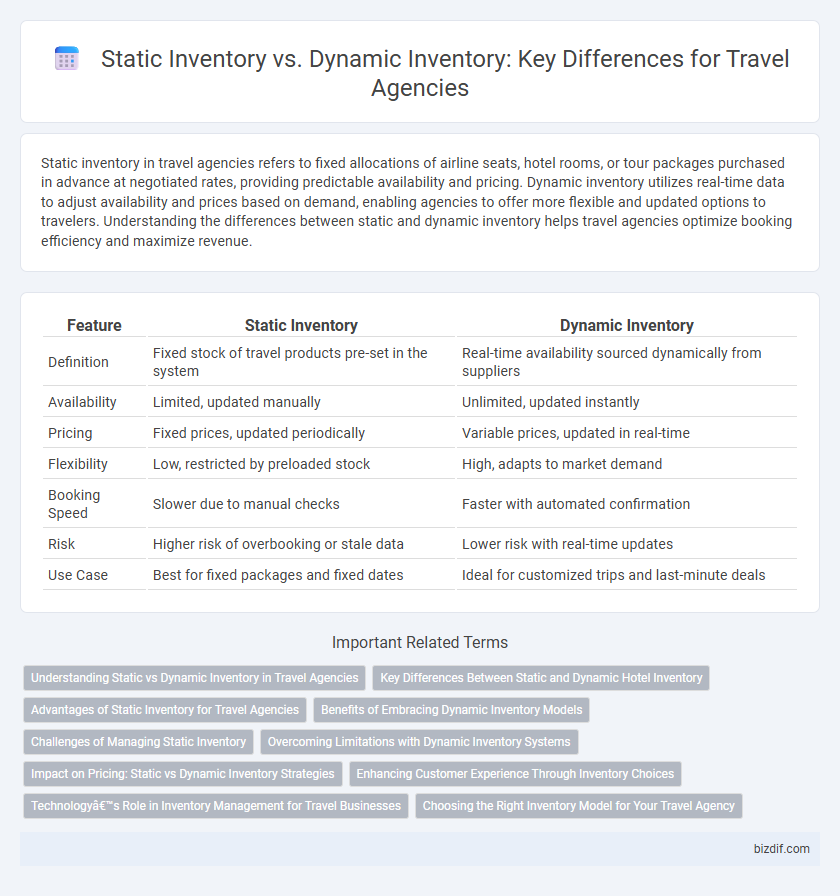Static inventory in travel agencies refers to fixed allocations of airline seats, hotel rooms, or tour packages purchased in advance at negotiated rates, providing predictable availability and pricing. Dynamic inventory utilizes real-time data to adjust availability and prices based on demand, enabling agencies to offer more flexible and updated options to travelers. Understanding the differences between static and dynamic inventory helps travel agencies optimize booking efficiency and maximize revenue.
Table of Comparison
| Feature | Static Inventory | Dynamic Inventory |
|---|---|---|
| Definition | Fixed stock of travel products pre-set in the system | Real-time availability sourced dynamically from suppliers |
| Availability | Limited, updated manually | Unlimited, updated instantly |
| Pricing | Fixed prices, updated periodically | Variable prices, updated in real-time |
| Flexibility | Low, restricted by preloaded stock | High, adapts to market demand |
| Booking Speed | Slower due to manual checks | Faster with automated confirmation |
| Risk | Higher risk of overbooking or stale data | Lower risk with real-time updates |
| Use Case | Best for fixed packages and fixed dates | Ideal for customized trips and last-minute deals |
Understanding Static vs Dynamic Inventory in Travel Agencies
Static inventory in travel agencies refers to fixed allocations of products such as hotel rooms, airline seats, or car rentals that are pre-negotiated and remain unchanged regardless of real-time demand. Dynamic inventory, on the other hand, is managed in real-time through live connections with suppliers, allowing prices and availability to adjust instantly based on market fluctuations and customer behavior. Understanding these distinctions enables travel agencies to optimize pricing strategies, improve customer satisfaction, and increase booking efficiency.
Key Differences Between Static and Dynamic Hotel Inventory
Static hotel inventory consists of pre-allocated rooms with fixed prices and availability, often limiting flexibility for last-minute changes. Dynamic hotel inventory updates in real-time based on demand, allowing variable pricing and instant booking adjustments. Key differences include pricing models, inventory control, and booking responsiveness, impacting how travel agencies manage customer options and optimize revenue.
Advantages of Static Inventory for Travel Agencies
Static inventory enables travel agencies to manage fixed allocations of rooms, flights, or packages, ensuring guaranteed availability and stable pricing for customers. This predictability simplifies booking processes and enhances customer trust by minimizing last-minute changes or cancellations. By controlling static stock, agencies can optimize revenue through negotiated rates and exclusive offers, improving overall profitability.
Benefits of Embracing Dynamic Inventory Models
Dynamic inventory models in travel agencies enable real-time updates on availability and pricing, maximizing revenue through demand-based adjustments. These models improve customer satisfaction by offering personalized, flexible options tailored to current market conditions. Embracing dynamic inventory reduces the risk of overbooking and enhances operational efficiency by integrating with multiple distribution channels seamlessly.
Challenges of Managing Static Inventory
Managing static inventory in travel agencies presents challenges such as limited flexibility to adjust for fluctuating demand, leading to potential overbooking or unsold capacity. Static inventory relies on pre-allocated resources, which can result in inefficient utilization and revenue loss during periods of low or high travel activity. The inability to dynamically update availability also hinders real-time pricing adjustments, impacting competitiveness in a rapidly changing market.
Overcoming Limitations with Dynamic Inventory Systems
Dynamic inventory systems enhance travel agencies' ability to offer real-time availability and pricing, overcoming the limitations of static inventory where fixed allocations often lead to unsold or overbooked services. By integrating live data feeds from airlines, hotels, and tour operators, dynamic inventory maximizes sales opportunities and improves customer satisfaction through accurate, up-to-date options. This technology-driven approach increases operational efficiency and allows travel agents to tailor offerings based on current market demand and traveler preferences.
Impact on Pricing: Static vs Dynamic Inventory Strategies
Static inventory fixes prices based on pre-negotiated rates, leading to stable but less flexible pricing structures that limit the ability to respond to real-time market demand. Dynamic inventory leverages real-time data and algorithms to adjust prices frequently, optimizing revenue by capitalizing on demand fluctuations and competitor pricing. Travel agencies using dynamic inventory strategies experience higher profit margins and improved customer targeting compared to static inventory models.
Enhancing Customer Experience Through Inventory Choices
Static inventory offers a fixed set of travel options that ensures consistency and reliability for customers seeking familiar packages. Dynamic inventory adapts in real-time to availability and demand, providing personalized and up-to-date choices to enhance customer satisfaction. Leveraging dynamic inventory allows travel agencies to deliver tailored experiences, optimize booking flexibility, and improve overall customer engagement.
Technology’s Role in Inventory Management for Travel Businesses
Technology revolutionizes travel businesses by enabling dynamic inventory management, which allows real-time updates and personalized customer experiences compared to static inventory's fixed data sets. Advanced software platforms integrate APIs from airlines, hotels, and car rental services to provide accurate availability and pricing, streamlining booking processes and maximizing revenue potential. Machine learning algorithms analyze booking patterns and demand fluctuations, optimizing inventory allocation to reduce overbooking and enhance operational efficiency.
Choosing the Right Inventory Model for Your Travel Agency
Selecting the right inventory model for your travel agency hinges on understanding the differences between static and dynamic inventory systems. Static inventory offers pre-negotiated fixed rates and guaranteed availability, ideal for agencies prioritizing price stability and supplier relationships. Dynamic inventory provides real-time availability and pricing, enabling flexibility and access to a broader range of options, critical for agencies targeting customized travel experiences and last-minute bookings.
Static Inventory vs Dynamic Inventory Infographic

 bizdif.com
bizdif.com